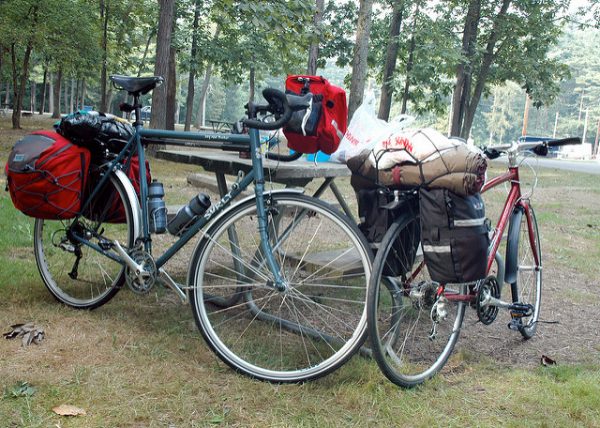

America celebrated its bicentennial on its bikes in 1976. The TransAmerica Trail was constructed that year so those capable could experience the expansive country in one of the most direct ways possible – bicycle touring.
Why a Cycling Tour?
Bicycling offers the ideal pace and placement for experiencing the countryside and cities alike. Quicker than walking, but more intimate than a road trip, cycle touring opens the landscape to the self-reliant traveler.
Cyclists typically carry enough supplies to last several days before needing to stop to refuel, so the heavy loads of pannier racks mean the experience of the landscape must be earned, often in the face of hills.

“Credit card touring” is a more expensive, but no doubt more enjoyable way to travel, with most nights spent in hotel rooms and most meals eaten at restaurants. This lightens the load of necessary equipment. Even more self-sufficient tourists recoup in a hotel room every few nights.
The TransAmerica Trail:
The TransAmerica Trail sets a particularly hilly route because it seeks to showcase the United State’s natural wonders. Larger roads would be a quicker, more direct passage, but the trail’s planner opted for a more off-beat ride.

You start the 4,262-mile trail in Astoria, Oregon and pass through eight other states before ending in Yorktown, Virginia. Most riders choose to ride east to west, and begin the three-month journey in May.
This allows them to avoid the late-summer heat of the plains and the chilly early-summer temperatures of the Rocky Mountains. This time frame allows you to enjoy the long days surrounding the June 21st summer solstice.
When Riding In The East:
If you’re riding east, the trail departs from the Chesapeake Bay and heads west into the historical fascinations of Colonial Williamsburg. Then it rolls through the grueling, undulating hills of the Appalachian Mountains in Kentucky.
Crossing the Ohio River brings you to Carbondale, Illinois. A lively college town is always a good place for a layover.
Crossing the Mississippi River gives you the opportunity for more historical side-trips, this time into places significant to the Civil War. The wavy plains of Missouri level into the long, flat, hot days of farmland in Kansas.
Fortunately, the Rocky Mountains come into view as you reach Pueblo, Colorado. The trail turns north, and ascends to the continental divide, crossing Hoosier Pass at an oxygen-deprived altitude of 11,542 feet.

Yellowstone National Park warrants a layover of at least a day, as do the Grand Tetons. These areas are the Rocky Mountains at their most rocky. The 13,000-foot peaks cut through the trees, beckoning to climbers. Stop here.
Missoula, The Cycling Headquarters:
Missoula, Montana is home to Adventure Cycling’s headquarters and is another cool town for a restful night in a hotel. Adventure Cycling sells maps that note the presence of grocery stores, hotels and attractions along the entire route.
The advent of smartphones makes these maps less of a necessity than they once were. A phone paired with a traveling solar charger will get you all the info you need.

Oregon presents you with some high, hot mountains before cooling into the lush Cascades and descending into Eugene, which is the largest city on the route. A more direct route to the Pacific is an option, but the trail follows the coastline north to Astoria.
The extra day is worth the time because the pacific northwest coastline is phenomenal. Some areas are so densely wooded that they’re classified as rainforests.
If You Cycle Across the USA:
Know something about your bike. The self-sufficiency of being able to make your own repairs complements the self-reliance you’ll need to propel yourself across the country.
Most riders know how to change an inner tube, but the ability to repair a broken spoke well enough to limp it into the next town carries a satisfying feeling along with its utility.
- The Low-Key Magic of Ghent, Belgium - April 22, 2024
- Discover the Hidden Charm of Extremadura in Spain - April 20, 2024
- Life of a Champion: Exploring the Muhammad Ali Center in Louisville - April 19, 2024

“Resentful night in a hotel”. Probably true 🙂, but I suspect you meant restful.
🙂 Thank you! We’ve made that change.